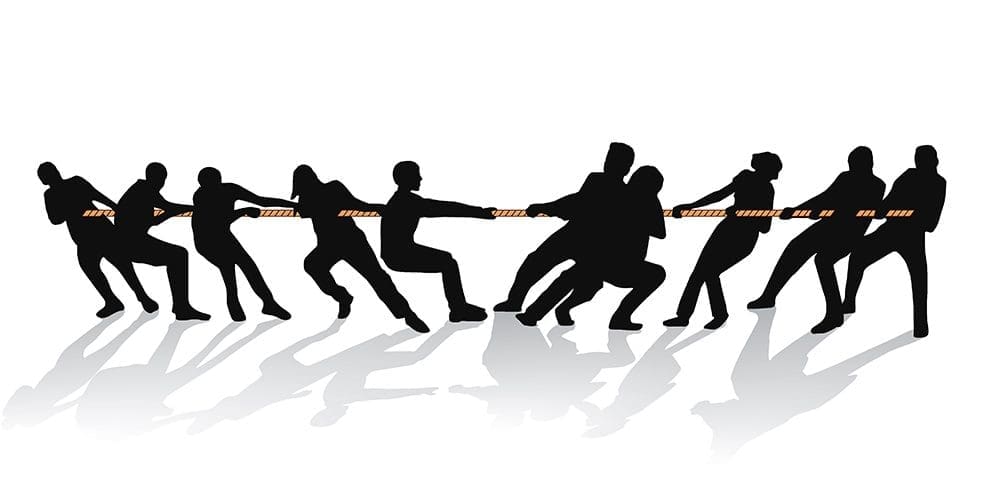
When good intention is met with resistance, what do you do?
“You have been called to heal wounds, to unite what has fallen apart,
and to bring home those who have lost their way.”
— St. Francis of Assisi
Have you ever been hijacked by a use of force? Even well-intended people are met with resistance, causing frustration, which can overwhelm their thoughtfulness. Before they know it, they’re using force. Like a riptide, this use of force pulls them away from their original, well-intended path.
If you find yourself choosing sides, this is a symptom of moving away from your target. Of not seeking cooperative outcomes but of trying to win. Or using force as tool to achieve your goals. That never works to the best advantage of anyone involved over the long haul. When intention interacts with resistance — with the elements of real life — frustration occurs and we start to label the person or situation as bad. When people choose tools beyond the tool of force, the bad thing often becomes a positive, something that produces better results and a healthier relationship.
In a world dancing with the use of power, force, and fear are you clear about your leadership and management style? How do you want to use your power? In what situations do you use force? And as Dr. Phil would say, “How’s that working for you?’”
In 2019, one of my favorite book recommendations was “It’s the Manager” by Clifton and Harter. The book represents data from the Gallup organization who research organizational effectiveness and employee engagement. Similar to their first book and findings, “First Break All the Rules,” the authors’ and Gallup’s data solidly supports the premise that the number one contributor to employee satisfaction, performance, and morale is the quality of the employee’s relationship with their manager. Good management competencies and interpersonal abilities are the best strategy for organizational healthy, performance, and sustainability.
No surprises here. However, how much time do you devote to your own development and that of the individuals around you who have the responsibility to not only do their work but to advance the work of others and the organization? What is your philosophy and your organization’s culture around power, engagement, and learning?
How does your organization engage in change? Handle mistakes? Coach performance?
We find ourselves at the start of a new decade, and with more than 50,000 new business books published each year telling us the same truth, can we recommit ourselves to fully embracing a 21st Century approach to our work environments, our working relationships, and our use of power?
If there is a tug of war in our world right now, it is simply a reflection of a very old struggle about power.
I want to be a champion of shared power, of collaborative action, of creating and engaging the capacity of others to move in the mission-direction under their own motivation.
I want to resist the rip-tide use of force.
I want to engage myself and others in conversations about how to align our how with our intentions — our well-intended what —to share stories and experiences about how to pursue good intentions without using force. To learn together about dealing successfully with difference by leaving enough space in which to reside — not just by choosing sides. Sides are polarizing. Holding space allows us to coexist along the Continuum of Change. So, how do we move from the restrictions of labels to the freedom of holding space?
I am recommitting to five behaviors that I came to understand when writing the book: “They Just Don’t Get It! Changing Resistance Into Understanding” (Berrett-Koehler 2005)
The five keys are:
1. Don’t place Blame, Take Responsibility
2. Force begets resistance, Practice Humility
3.Telling turns them off, Begin with Questions
4. Being might be wrong, Remain Open
5. If you believe they can’t, they won’t; Believe They Can
Do you ever have a “Where did that statement/action come from?” moment?
Even the most self-aware of us has those moments in which our past behaviors break through and exhibit themselves in an action or statement which no longer is part of who we are. The result is often unnerving, cataclysmic, and glaringly out of alignment.
So what do we do when this happens?
1. Forgive. Recognize your human frailty and rededicate yourself. We are transcendent in letting go of force, fear, and ego. It opens up for a transcendent moment of powerless, humanity, and seeing this with a clean eye
2. Recommit. We are human and hopelessly flawed. This is a moment to start again, a new slate. Embrace the opportunity.
3. Realize that if you want to be successful, you have to be willing to fail repeatedly.
4. Return to a restore point. Reread the 5 keys.
5. Maintain physical balance. When you’re imbalanced you go can become unbalanced.
6. Halt. When you’re hungry, angry, lonely, or tired — stop.
As our new decade continues, I am focusing on, “How not to become frayed by a fraying world.”
I am going to begin each day with the intention of trying not to hurt others in my efforts to do good things. And my guide will be the Five Keys.
May the Force (of good) be with you.
Leslie
Grant me the serenity to accept the things I cannot change,
courage to change the things I can,
and the wisdom to know the difference.
— Reinhold Niebunr
